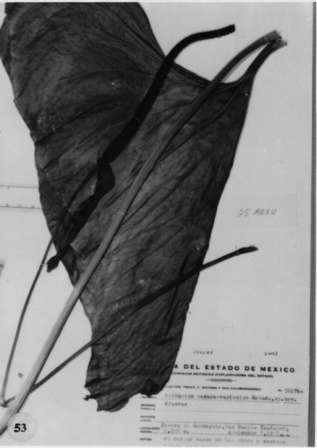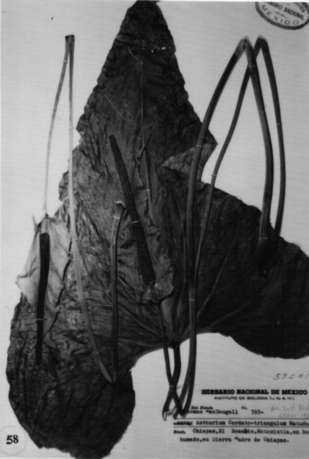




Anthurium cordatotriangulum Matuda,
Anales Inst.Biol.Univ.Nac. Mexico 36: 109. 1966. TYPE: Mexico. Chiapas: Motozinlla; Sierra Madre de Chiapas, El Rosario (ca. 8 mi S of Motozintia), 1,800 m elev., MacRougall 393 (MEXU, holotype).
Stems short; cataphylls broadly triangular, 5- 7 cm long, drying and weathering into persistent fibers.
LEAVES with petiole 50-55 cm long, 5- 8 mm diam., broadly silicate, stiff; geniculum 2-3 cm long; blades broadly ovate-triangular, subcoriaceous, gradually acuminate at apex, broadly lobed at base, 37-64 cm long, 26-46 cm diam., broadest at point of petiole attachment or just below; the anterior lobe 30-44 cm long; the posterior lobes 11-23 cm long, directed outward at ca. 45° angle from petiole; the sinus parabolic to hippocrepiform, round at apex; the midrib raised above and below; basal veins 5 or 6 pairs, the third to sixth coalesced 3-6 cm, raised above and below; primary lateral veins 5 or 6 per side, departing midrib at 60° angle, ± straight, usually prominently loop-connected into collective vein in apical half of blade; the collective vein arising from the first basal vein or sometimes from one of the lower primary lateral veins.
INFLORESCENCE usually longer than leaves; peduncle subterete, to 57 cm long, ca. 5 mm diam.; spathe moderately thick, green, lanceolate, 14-18 cm long, 2.5-4.5 cm wide, long-acuminate at apex, rounded and ± clasping at base; stipe to 15 mm long in front, 6 mm long in back; spadix purplish (dried), 10-13 cm long, 8-10 mm diam. at base, 4-5 mm diam. At apex; the flowers rhombic, 2.7-3.1 mm long, 1.5-2.2 mm wide; 7-9 flowers visible in the principal spiral; tepals weakly punctate; pistils not emergent; stigma 3-3.5 mm long, broadly elliptic; stamens emerging from base and held just above tepals in a tight cluster; thecae oblong-elliptic, scarcely divaricate.
INFRUCTESCENCE not seen. Figs. 53 and 58.
Anthurium cordatotriangulum is known for certain only from the southeastern corner of Chiapas near the Guatemalan border in Molozinila and Union Juarez in the Sierra Madre de Chiapas at 1,800 to 1,900 m in oak-pine forest. Two other closely related species, A. montanum and A. chamulense, have been collected at The type locality of A cordatotriangulum. A collection from San Carlos Yautepec in the Sierra de Lacheguia in South Central Oaxaca matches the type of A. cordatotriangulum very well but it is difficult to explain the otherwise apparent endemism of this species. (This specimen bears the unpublished herbarium name of A. oaxacarupicolum Matuda but since the collection diners in no appreciable way from A. cordatotriangulum it will not be recognized here.) The region around San Carlos Yautepec is very arid and nearly devoid of habits for Anthurium. I suspect that the label data referring to San Carlos Yautepec was intended to refer to the municipio of the same name which is very large and no doubt includes good Anthurium habitats in the southern part. The species is placed in section Belolonchium and is distinguished by its almost deltoid blades, its coarsely elevated basal and primary lateral veins (on drying), broad ovate-lanceolate spathe, and long-tapered, violet-purple spadix. Although Matuda compared the species with A. macdougalii (A. andicola), it is perhaps most easily confused with A. montanum, which occurs in the same area in southeastern Chiapas, but that species differs in having narrowly ovate blades, scarcely raised veins (on drying), a generally much smaller spathe, and a spadix that is less conspicuously long-tapered.
 |
 |
Mexico Chiapas:, , MacDougall 393 (MEXU).
Mexico Chiapas:, , Matuda 38628 (MEXU).
Mexico Chiapas: Volcán Tacana,, , Matuda 38626 (MEXU).
Mexico Oaxaca:, , Matuda 38276 (MEXU).